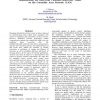Free Online Productivity Tools
i2Speak
i2Symbol
i2OCR
iTex2Img
iWeb2Print
iWeb2Shot
i2Type
iPdf2Split
iPdf2Merge
i2Bopomofo
i2Arabic
i2Style
i2Image
i2PDF
iLatex2Rtf
Sci2ools
ISORC
1999
IEEE
1999
IEEE
Implementing the Real-Time Publisher/Subscriber Model on the Controller Area Network (CAN)
Designing distributed real-time systems as being composed of communicating objects offers many advantages with respect to modularity and extensibility of these systems. However, distributed real-time applications exhibit communication patterns that significantly differ from the traditional object invocation style. The publisher/subscriber model for inter-object communication matches well with these patterns. Any implementation of that model must address the problems of binding subscribers to publishers, of routing and filtering of messages, as well as reliability, efficiency and latency of message delivery. In the context of real-time applications, all these issues must be subject to a rigid inspection with respect to meeting real-time requirements. We argue that for embedded control systems built around smart microcontroller-powered devices these requirements can only be met when exploiting the properties of the underlying network. The CAN-Bus (CAN: Controller Area Network) which is ...
Distributed And Parallel Computing | ISORC 1999 | Publisher/subscriber Model | Real-time | Real-time Applications |
| Added | 04 Aug 2010 |
| Updated | 04 Aug 2010 |
| Type | Conference |
| Year | 1999 |
| Where | ISORC |
| Authors | Jörg Kaiser, Michael Mock |
Comments (0)

